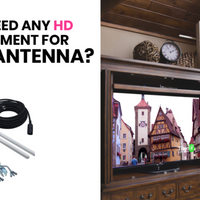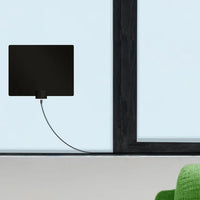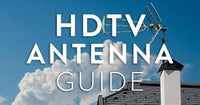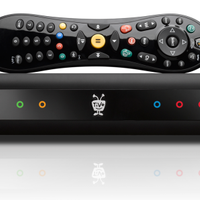When it comes to improving your TV viewing experience, adding an antenna to your setup can significantly enhance the number of channels you receive and the quality of your signal. Understanding the process of selecting, setting up, and troubleshooting common issues with your antenna is crucial for maximizing the benefits of this technology.
How to Choose the Right Antenna for Your Needs
Before delving into the setup process, it's essential to choose the right antenna for your specific requirements. Different types of antennas are available in the market, each catering to varying signal reception needs.

-
Indoor Antennas: These antennas are generally compact and designed for use inside a house or apartment. They are usually easy to install and don't require professional setup. Indoor antennas are best suited for urban areas with strong signal reception.
2. Outdoor Antennas: Outdoor antennas are larger and more powerful than indoor antennas. They are designed to be mounted on rooftops or outdoor walls to maximize signal reception. Outdoor antennas are ideal for rural areas or locations with weak signal strength.
3. Directional Antennas: Directional antennas are designed to receive signals from a specific direction. They are ideal for areas where the broadcast towers are located in a specific direction. Directional antennas can provide better signal quality and reception compared to omnidirectional antennas.
4. Omnidirectional Antennas: Omnidirectional antennas receive signals from all directions. They are suitable for areas with multiple broadcast towers located in different directions. Omnidirectional antennas are typically easier to set up as they do not require precise alignment with the towers.
5. Amplified Antennas: Amplified antennas come with built-in signal amplifiers to boost weak signals and enhance reception. They are ideal for locations with poor signal strength or where obstacles such as buildings or trees may obstruct signal reception.
Once you have chosen the right antenna for your needs, follow these steps to set it up:
1. Find the optimal location for mounting the antenna. This will depend on factors such as signal strength, proximity to broadcast towers, and potential obstructions.
2. Mount the antenna securely using the provided mounting hardware. Ensure that it is positioned correctly to maximize signal reception.
3. Connect the antenna to your TV or tuner using the coaxial cable provided. Make sure the connection is secure to avoid signal interference.
4. Scan for channels on your TV or tuner to detect all available broadcast channels. This may vary depending on the device you are using, so consult the user manual for specific instructions.
5. Fine-tune the antenna position if necessary to improve signal reception. You may need to adjust the direction or angle of the antenna slightly to achieve the best signal quality.
By following these steps and choosing the right antenna for your needs, you can enjoy reliable and clear reception of over-the-air broadcast channels on your TV.
Understanding Different Types of Antennas
Antennas come in various forms such as indoor, outdoor, flat, and attic antennas. Indoor antennas are suitable for urban areas with strong signals, while outdoor antennas are ideal for rural locations with weaker signals. Flat antennas are a newer, sleeker option that can be easily hidden behind a TV or mounted on a wall. Attic antennas are installed in the attic of a home and are a good choice for those who do not want to mount an antenna on the roof.
Antennas work by picking up radio frequency signals from broadcast towers and converting them into a TV signal that can be displayed on a television screen. They are a cost-effective way to access local channels without the need for a cable or satellite subscription.

When choosing an antenna, it is important to consider factors such as the distance to broadcast towers, the type of signals in your area (VHF or UHF), and the terrain surrounding your location. Additionally, it is helpful to research different antenna models to find one that best fits your needs and budget.
Overall, antennas are a versatile and reliable option for accessing free over-the-air TV channels, making them a popular choice for many households looking to cut the cord and save money on their entertainment expenses.
Factors to Consider When Selecting an Antenna
When selecting an antenna, consider factors like your location, distance from broadcast towers, signal strength, and the channels you wish to access. These factors play a crucial role in determining the effectiveness of your antenna. Additionally, the type of antenna you choose can also make a difference in performance. There are indoor antennas, outdoor antennas, and amplified antennas, each with their own advantages and disadvantages.
It's important to also consider the size and design of the antenna, as larger antennas tend to have better range and reception capabilities.
Finally, make sure to research the different options available on the market and read reviews from other users to ensure you select the best antenna for your specific needs.
Indoor vs. Outdoor Antennas: Pros and Cons
Indoor antennas are convenient and easy to install, but they may have limitations in receiving weaker signals. On the other hand, outdoor antennas provide better reception but require professional installation and maintenance. Indoor antennas are typically smaller and less powerful than outdoor antennas, which can affect their ability to pick up weaker signals, especially in areas with poor signal strength or interference. Outdoor antennas, on the other hand, are usually larger and placed in a higher position, which allows them to capture signals more effectively.
Outdoor antennas generally provide better reception for both VHF and UHF signals, which can be advantageous in areas with more spread out or inconsistent antenna signals. They can also be positioned in a way that minimizes obstructions like buildings or trees, which can interfere with the signal.
While indoor antennas are easy to install and can be placed discreetly inside your home, outdoor antennas require more effort and expertise to install. They may also require additional equipment like a mast or amplifier to boost the signal strength. Additionally, outdoor antennas may need regular maintenance to ensure they are working properly and to prevent damage from weather or wildlife.
Ultimately, the choice between an indoor or outdoor antenna depends on your location, the strength of the signals in your area, and your specific needs and preferences. If you are struggling to pick up channels with an indoor antenna, it may be worth considering upgrading to an outdoor antenna for better reception.
Setting Up Your TV Antenna
Once you've selected the right antenna, the next step is to set it up correctly to ensure optimal performance. Proper installation and positioning are key to maximizing signal reception. Here are some tips on how to set up your antenna:
1. Choose the right location: The location of your antenna can greatly impact its performance. It is best to place your antenna in an area with minimal obstructions, such as walls or trees, to ensure a clear line of sight to the broadcast towers.
2. Install the antenna at the highest point possible: Mounting your antenna at the highest point on your roof or outside your home can help improve signal reception. Avoid placing your antenna in a basement or attic, as this can interfere with signal reception.
3. Point the antenna in the right direction: Depending on your location and the location of the broadcast towers, you may need to point your antenna in a specific direction to pick up the strongest signal. You can use a signal strength meter or a compass to help determine the best direction to point your antenna.
4. Securely mount the antenna: Make sure to securely mount your antenna to a stable structure, such as a roof or a pole, to prevent it from moving or shifting in strong winds. Use appropriate mounting hardware and follow the manufacturer's instructions for installation.
5. Connect the antenna to your TV: Once you have installed the antenna, connect the coaxial cable from the antenna to your TV or tuner. Make sure the connection is secure and that the cable is not damaged or frayed.
6. Scan for channels: After setting up your antenna, scan for channels on your TV or tuner to see which channels you can pick up. You may need to reposition or adjust the antenna to fine-tune the signal reception.
By following these tips, you can ensure that your antenna is properly set up for optimal performance. Remember to regularly check and adjust your antenna as needed to maintain a clear and consistent signal.
Scanning for Channels After Connecting the Antenna

After connecting your antenna to the TV's antenna input, scan for channels to detect all available options. This process allows your TV to recognize the new channels provided by the antenna. Here are the steps to scan for channels on your TV:
1. Turn on your TV and press the "Menu" button on your remote control.
2. Navigate to the "Settings" or "Setup" option using the arrow keys on your remote.
3. Look for the "Channels" or "Tuning" option in the settings menu.
4. Select "Scan" or "Auto-Tune" to initiate the channel scan process.
5. The TV will begin scanning for available channels. This process may take a few minutes to complete.
6. Once the scan is finished, your TV will display a list of detected channels.
7. You can now navigate through the channels using the channel buttons on your remote control.
If your TV does not automatically detect all available channels, you may need to adjust the antenna position or re-scan for channels. Make sure your antenna is properly connected and positioned for optimal signal reception.
By scanning for channels, you can access a variety of free broadcasts available over-the-air with your antenna, including local news, sports, and entertainment channels. Enjoy watching your favorite TV programs in high definition with the help of your antenna.
Locating the Ideal Position for Your Antenna
Placement plays a vital role in the performance of your antenna. Experiment with positioning to find the optimal location that offers the best signal reception. Factors like obstacles and interference can affect signal strength. Some tips for optimizing placement include:
1. Avoid placing the antenna near metal objects or walls that could block the signal.
2. Position the antenna higher up, like on a window sill or bookshelf, to reduce interference.
3. Experiment with rotating the antenna to find the best angle for reception.
4. Keep the antenna away from other electronic devices that could cause interference.
5. If possible, try moving the antenna closer to the broadcast source for a stronger signal.
By taking the time to test different placement options, you can improve the performance of your antenna and enjoy clearer reception.
Amplifying Your Antenna Signal for Better Reception
To enhance signal strength and improve reception quality, consider using an amplifier with your antenna setup. Amplifiers help boost weak signals, especially in areas with significant interference or distance from broadcast towers. Additionally, make sure your antenna is positioned correctly to receive the best possible signal. This may involve adjusting the antenna's direction, height, or angle to optimize reception. In some cases, upgrading to a higher-gain antenna may also improve signal strength.
It's also important to minimize obstructions that can block or interfere with the signal, such as tall buildings, trees, or other structures. Positioning your antenna in a clear line of sight to the broadcast tower can help reduce interference and improve reception.
Regularly checking and repositioning your antenna, as well as scanning for new channels or adjusting settings on your TV or tuner, can also help optimize your reception quality. By taking these steps and using an amplifier if needed, you can ensure the best possible signal strength and reception quality for your antenna setup.
Utilizing Your Antenna for Free TV
One of the primary advantages of using an antenna is the ability to access free over-the-air television channels. By leveraging your antenna setup effectively, you can enjoy a wide range of local channels without the need for a cable subscription. Another advantage of using an antenna is the potential for better picture quality compared to cable or satellite TV. Antennas can provide uncompressed HD signals, resulting in sharper images and better sound quality.
Additionally, using an antenna can provide access to channels that may not be available through cable or satellite providers. This includes local and niche channels that cater to specific interests or communities.

Antennas are also a more environmentally friendly option compared to cable or satellite TV, as they require less energy to operate and produce fewer emissions.
Overall, using an antenna can be a cost-effective and efficient way to access a variety of television channels while also benefiting from improved picture and sound quality.
Accessing Local Channels Using Your Antenna
Local channels broadcast news, sports, and other programs that cater to specific regions. With an antenna, you can access these channels in high definition without incurring any additional costs beyond the initial setup.
Understanding the Benefits of Over-the-Air Television
Over-the-air (OTA) television provides a cost-effective way to enjoy a variety of channels without monthly subscription fees. It offers a diverse selection of programming, including network shows, local news, and educational content.
Upgrading to NextGen TV with a Digital Antenna
NextGen TV, also known as ATSC 3.0, offers advanced features like 4K resolution, immersive audio, and interactive content. To experience the benefits of NextGen TV, consider upgrading to a digital antenna that is compatible with this new broadcasting standard.
Troubleshooting Common Antenna Issues
Despite proper setup, antenna systems may encounter issues that affect signal reception. It's essential to identify and address common problems promptly to maintain optimal performance.
Dealing with Signal Interference and Weak Reception
Signal interference from electronic devices, buildings, or geographical features can weaken your antenna signal. To mitigate this, try repositioning your antenna and minimizing sources of interference.
Using a Tuner to Enhance Channel Quality
A tuner helps adjust and optimize your TV's reception capabilities, ensuring clear and crisp channel quality. By fine-tuning your tuner settings, you can improve the viewing experience and minimize signal disruptions.
Considering an Amplifier for Long-Distance Channel Reception
For users situated far from broadcast towers, amplifiers can extend the reach of your antenna and enhance reception over long distances. Investing in a quality amplifier can significantly improve signal strength and channel availability.
Enhancing Your TV Setup with Antenna Accessories

In addition to the antenna itself, various accessories can complement and improve your TV setup for optimal performance. These accessories provide additional functionality and convenience for multiple TV installations.
Connecting Your Antenna to Multiple TVs with a Splitter
If you have more than one TV in your household, a splitter allows you to connect a single antenna to multiple televisions simultaneously. This setup enables each TV to access the same range of channels without the need for separate antennas.
Choosing the Right Coaxial Cable for Your Antenna Setup
The quality of the coaxial cable used in your antenna setup can impact signal transmission and overall performance. Selecting a high-quality cable ensures minimal signal loss and interference, resulting in enhanced viewing experience.
Installing an Antenna in Your Attic for Improved Signal Strength
For users facing signal reception challenges, installing an antenna in the attic can provide a viable solution. Attic antennas offer improved signal strength by minimizing obstructions and interference typically encountered outdoors.







